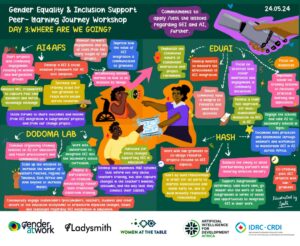This graphic was designed by Liisa Sorsa of thinklinkgraphics to illustrate the key points that G@W Associate Jeremy Holland made in a densely written research paper on measuring gender equality. Graphic recording is visual thinking. Since most of us process information visually, giving visual form to papers, presentations, and workshop proceedings increases clarity of ideas, deepens engagement, and inspires linking of disparate ideas. When people see their words take visual shape they feel heard and validated. A number of years ago, while facilitating a workshop in Jersualem with Palestinians and Israelis on ending religiously motivated violence, we decided to have a colleague visually record the proceedings. As the graphic took shape, the tension in the room subsided as conflicting ideas came together side by side to make a whole. The arguing between Israelis and Palestinians subsided and they used their energy to engage with the ideas they generated which were on a twenty foot banner in front of them.
The graphic above performed magic. Just to give you a background, this was part of a Measuring Gender Equality Initiative launched in collaboration with the Participation, Power and Social Change (PPSC) Team in the Institute of Development Studies at the University of Sussex, and funded by NORAD, the Global Fund for Women and UN Women. It took place in May 2011 and brought together 26 participants from 12 countries. These participants represented organizations working at all levels of international cooperation for social change from women’s organizations, university settings and donor agencies. At the heart of the initiative was a desire to initiate a ‘community of learning’ by bringing together donors and activists at all levels of the system.
Jeremy Holland presented the prepared background paper Measuring Gender Equality in Organisational Learning: A Background Paper (Holland and Sheppard, Gender at Work, 2011), underscoring how measuring, understanding and communicating social change in gender relations plays a critical yet elusive part in tackling gender equality.
A better understanding of the processes at play is essential for both internal organizational change and for development interventions through reflective practice. The issue remains that traditional linear tools for M&E are ineffective on their own in supporting this type of organizational learning as tracking changes in gender relations and/or organizational cultures are complex, long-term, and context specific. Too often there is a mismatch between donors managing for results, the evaluation community’s concern for complexity, and activists and practitioners who are busy with day-to-day activities.
Holland emphasized that how change is conceptualized affects how it is measured, therefore, it is important to start with a strong theoretical basis and then use appropriate methods to test the theory.
For organizations to use evidence about what works best for gender equality, they need to be able to reflect on power relations (both the incentives and vested interests) that shape and maintain the status quo. Some of the methods outlined in the paper are participatory instruments which quantify relational change through scorecards—tools which are at their best when they integrate description of change with qualitative explanation of change.
For organizations to use evidence about what works best for gender equality, they need to be able to reflect on power relations (both the incentives and vested interests) that shape and maintain the status quo. An overview of the variety of methods for measuring social change was presented, as you can see in the graphic. Liisa and I worked with the paper to translate the academic prose into everyday language, checking back with Jeremy to ensure we got it right. We identified the key themes—the bold ideas on the measuring tape, then Liisa had at it. When she finished, we sent a draft to Jeremy—who accepted it as created. When she and I went over it in detail, we found a few more things to change; and when we got to the UK, where the workshop was begin held, Jeremy saw the large poster for the first time in its grandness. He did request a few minor changes, which we made later to the graphic and the image you see here is the final graphic.
The key idea with graphic recording is something we all know: most of us are visually oriented, yet we try to learn or present our concepts through speaking (usually one way) or through bullet points, which miss the whole, and fragment any sense of larger meaning. Graphics put the ideas in simple pictures and words. Instead of attaching ideas to a person and interpreting the ideas based on your notions of the person, the graphic becomes objective material that people discuss and challenge in productive conversations. It’s a great way to summarize research and capture ideas from meetings so that everyone sees the whole, rather than relying on the slipperiness of bullet points and memory.
by RAY GORDEZKY



